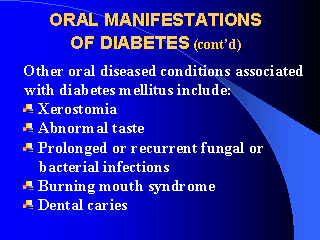|
|
|
|
front |1 |2 |3 |4 |5 |6 |7 |8 |9 |10 |11 |12 |13 |14 |15 |16 |17 |18 |19 |20 |21 |22 |23 |24 |25 |26 |27 |28 |29 |30 |31 |32 |33 |34 |review |
 |
Oral Manifestations of Type 2 Diabetes Mellitus: (cont'd)
Oral manifestations of diabetes mellitus have been widely described in the literature and primarily focus on an increased prevalence and severity of periodontitis. In addition to periodontitis, however, uncontrolled or poorly controlled diabetics are at an increased risk for a variety of other oral complications including:
Dental public health education and prevention programs to promote a satisfactory level of personal control of diabetes mellitus and personal oral hygiene should be directed at populations most susceptible to Type 2 Diabetes Mellitus, of which the most consistently identified are the Mexican-American population of the American Southwest, particularly the people of the United States-Mexico Border. |